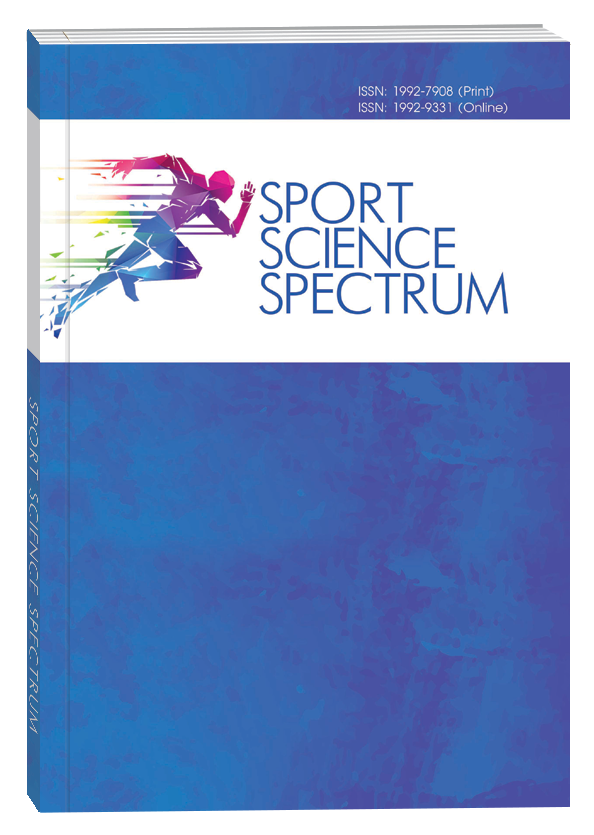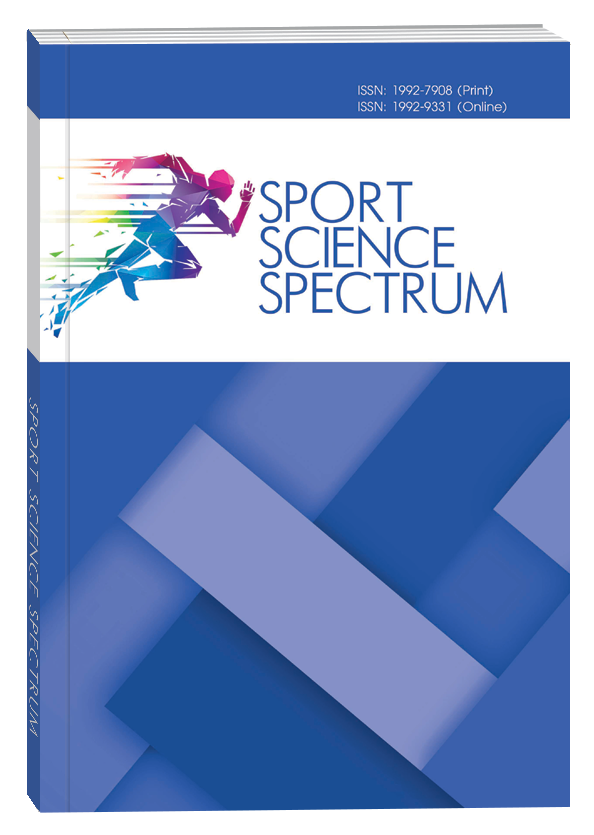A STUDY ON THE EFFECTIVENESS OF GAME TIME PLANNING FOR FEMALE BASKETBALL PLAYERS CONSIDERING PSYCHOPHYSIOLOGICAL CHARACTERISTICS ACROSS OVARIAN-MENSTRUAL CYCLE PHASES
DOI:
https://doi.org/10.32782/spectrum/2025-1-9Keywords:
psychophysiological characteristics, game time, ovarian-menstrual cycleAbstract
Introduction. The study of the effectiveness of game-time planning for women’s teams in sports games addresses the need to consider athletes’ psychophysiological characteristics to enhance performance. Previous research identified links between technical skills, psycho-emotional state, and success, forming the basis for this study’s goal: to evaluate the effectiveness of game-time planning using innovative approaches tailored to athletes’ psychophysiological traits for team optimization. Methods. The research involved 18 athletes from the “Frankivsk-Prykarpattya” team.It employed psychosocial questionnaires, pedagogical observations, experiments with innovative technologies, biomedical methods, and statistical analysis. Results. Within the framework of a pedagogical experiment involving Superleague female basketball players, a methodology for planning game time was developed, considering the psychophysiological characteristics and emotional state of the athletes, alongside the utilization of innovative technologies. The results of the comparative analysis demonstrated that the effectiveness of rebounds under the opponent’s basket increased by 1.1 %, under their basket by 14 % (reaching 82.1 %), and the overall rebound indicator rose by 3.2 %. The percentage of ball losses decreased by 3.1 %, while the ratio of steel to losses improved from 0.5 to 0.6. The indicators “Points in paint” and “Second chance points” increased by 2 points.Correlation analysis revealed a high correlation between technical preparedness and rebound effectiveness (r = 0.72), a negative relationship between psychoemotional state and ball losses (r = -0.68), and a positive influence of technologies on steels (r = 0.65). This methodology substantiated the effectiveness of an individualized approach and the application of modern technologies in optimizing the training of female athletes. Conclusions. The developed methodology for planning the game time of highly qualified female basketball players, grounded in the psychophysiological characteristics and emotional state of the athletes with the application of innovative technologies, contributed to a statistically significant improvement in technical- tactical indicators, specifically an increase in rebound effectiveness, a reduction in ball losses, and an enhancement of defensive activity. The integration of modern technologies and comprehensive analysis into the training of highly qualified female basketball players ensures an increase in the effectiveness of game actions, the overall productivity of the team, and the optimization of the training process through an individualized approach that accounts for the physiological and psychological characteristics of the athletes.
References
1. Шахліна Л. Медико-біологічні основи спортивної підготовки жінок у сучасному спорті вищих досягнень. Теорія і методика фізичного виховання і спорту. 2020. № 2. С. 95–104. DOI: https://doi.org/10.32652/tmfvs.2020.2.95-104
2. Шахліна Л. Сучасний погляд на проблему синдрому «тріада жінки-спортсменки». Спортивна медицина, фізична терапія та ерготерапія. 2021. № 1. С. 3–13. DOI: https://doi.org/10.32652/spmed.2021.1.3-13
3. Armour M., Parry K. A., Steel K., Smith C. A. Australian female athlete perceptions of the challenges associated with training and competing when menstrual symptoms are present. International Journal of Sports Science & Coaching. 2020. Vol. 15, no. 3. P. 316–323. DOI: https://doi.org/10.1177/1747954120916073
4. Dam T. V., Dalgaard L. B., Sevdalis V., Bibby B. M., Janse D. E. J. X., Gravholt C. H., Hansen M. Muscle performance during the menstrual cycle correlates with psychological well-being, but not fluctuations in sex hormones. Medicine & Science in Sports & Exercise. 2022. Vol. 54, no. 10. P. 1678–1689. DOI: https:// doi.org/10.1249/mss.0000000000002961
5. Dole A., Beaven M., Sims S. T. Menstrual cycle tracking in sports research: challenges, progress, and future directions. Physiologia. 2023. Vol. 3, no. 4. P. 598–610. DOI: https://doi.org/10.3390/physiologia3040044
6. Dupuit M., Meignié A., Chassard T., Blanquet L., LeHeran J., Delaunay T., Bernardeau E., Toussaint J., Duclos M., Antero J. On-field methodological approach to monitor the menstrual cycle and hormonal phases in elite female athletes. International Journal of Sports Physiology and Performance. 2023. Vol. 18, no. 10. P. 1169–1178. DOI: https://doi.org/10.1123/ijspp.2022-0287
7. Elliott-Sale K. Ovarian hormones 101: how to conduct high-quality sport and exercise science research on female athletes. Sports Science Exchange. 2023. Vol. 36, no. 235. P. 1–7. DOI: https://doi.org/10.1249/sse.0000000000000235
8. Findlay R. J., Macrae E. H. R., Whyte I. Y., Easton C., Forrest L. J. How the menstrual cycle and menstruation affect sporting performance: experiences and perceptions of elite female rugby players. British Journal of Sports Medicine. 2020. Vol. 54, no. 18. P. 1108–1113. DOI: https://doi.org/10.1136/ bjsports-2019-101486
9. Fridén C., Hirschberg A. L., Saartok T. Muscle strength and endurance do not significantly vary across 3 phases of the menstrual cycle in moderately active premenopausal women. Clinical Journal of Sport Medicine. 2003. Vol. 13, no. 4. P. 238–241. DOI: https://doi.org/10.1097/00042752-200307000-00007
10. Gordon D., Hughes F., Young K., Scruton A., Keiller D., Caddy O., Baker J., Barnes R. The effects of menstrual cycle phase on the development of peak torque under isokinetic conditions. Isokinetics and Exercise Science. 2013. Vol. 21, no. 4. P. 285–291. DOI: https://doi.org/10.3233/ies-130499
11. Güler İ. Investigation of the effect of menstruation period on sportive performance of women’s volleyball players. African Educational Research Journal. 2020. Vol. 8, no. 2. P. 387–391. DOI: https://doi.org/10.30918/aerj.82.20.068
12. Kishali N. F., Imamoglu O., Katkat D., Atan T., Akyol P. Effects of menstrual cycle on sports performance. International Journal of Neuroscience. 2006. Vol. 116, no. 12. P. 1549–1563. DOI: https://doi.org/10.1080/00207450600675217
13. Köse B. Analysis of the effect of menstrual cycle phases on aerobic-anaerobic capacity and muscle strength. Journal of Education and Training Studies. 2018. Vol. 6, no. 8. P. 23–28. DOI: https://doi.org/10.11114/jets.v6i8.3207
14. Lebrun C. M., McKenzie D. C., Prior J. C., Taunton J. E. Effects of menstrual cycle phase on athletic performance. Medicine and Science in Sports and Exercise. 1995. Vol. 27, no. 3. P. 437–444. DOI: https://doi.org/10.1249/00005768-199503000-00022
15. Martin D., Sale C., Cooper S. B., Elliott-Sale K. J. Period prevalence and perceived side effects of hormonal contraceptive use and the menstrual cycle in elite athletes. International Journal of Sports Physiology and Performance. 2018. Vol. 13, no. 7. P. 926–932. DOI: https://doi.org/10.1123/ijspp.2017-0330
16. Meignié A., Duclos M., Carling C., Orhant E., Provost P., Rabita G., Antero J. The effects of menstrual cycle phase on elite athlete performance: a critical and systematic review. Frontiers in Physiology. 2021. Vol. 12. Article 654585. DOI: https://doi.org/10.3389/fphys.2021.654585
17. Phillips S. K., Sanderson A. G., Birch K., Bruce S. A., Woledge R. C. Changes in maximal voluntary force of human adductor pollicis muscle during the menstrual cycle. The Journal of Physiology. 1996. Vol. 496, no. 2. P. 551–557. DOI: https://doi.org/10.1113/jphysiol.1996.sp021706
18. Rodrigues P., Correia M., Wharton L. Effect of menstrual cycle on muscle strength. Journal of Exercise Physiology Online. 2019. Vol. 22, no. 5. P. 89–97. URL: https://www.asep.org/asep/asep/JEPonlineOCTOBER2019_Rodrigues.pdf
19. Romero-Moraleda B., Coso J. D., Gutierrez-Hellin J., Ruiz-Moreno C., Grgic J., Lara B. The influence of the menstrual cycle on muscle strength and power performance. Journal of Human Kinetics. 2019. Vol. 68, no. 1. P. 123–133. DOI: https://doi.org/10.2478/hukin-2019-0061
20. Sarwar R., Niclos B. B., Rutherford O. M. Changes in muscle strength, relaxation rate and fatiguability during the human menstrual cycle. The Journal of Physiology. 1996. Vol. 493, no. 1. P. 267–272. DOI: https://doi.org/10.1113/jphysiol.1996.sp021381
21. Tenan M. S., Hackney A. C., Griffin L. Maximal force and tremor changes across the menstrual cycle. European Journal of Applied Physiology. 2016. Vol. 116, no. 1. P. 153–160. DOI: https://doi.org/10.1007/s00421-015-3258-x





